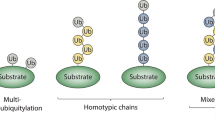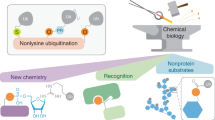Abstract
Ubiquitin functions by covalently modifying other proteins. In the past few years, a surprising number of other proteins have been identified that, despite often being only slightly similar to ubiquitin, can also be attached to proteins. Newly discovered parallels between the activation of ubiquitin and the biosynthesis of certain enzyme cofactors now hint at the possible evolutionary origins of the ubiquitin system.
This is a preview of subscription content, access via your institution
Access options
Subscribe to this journal
Receive 12 print issues and online access
$209.00 per year
only $17.42 per issue
Buy this article
- Purchase on Springer Link
- Instant access to full article PDF
Prices may be subject to local taxes which are calculated during checkout




Similar content being viewed by others
References
Haas, A. L. & Siepmann, T. J. Pathways of ubiquitin conjugation . FASEB J. 11, 1257–1268 (1997).
Hochstrasser, M. There’s the Rub: a novel ubiquitin-like modification involved in cell cycle regulation. Genes Dev. 12, 901– 907 (1998).
Vierstra, R. D. & Callis, J. Polypeptide tags, ubiquitous modifiers for plant protein regulation. Plant Mol. Biol. 41, 435–442 ( 1999).
Thrower, J. S., Hoffman, L., Rechsteiner, M. & Pickart, C. M. Recognition of the polyubiquitin proteolytic signal. EMBO J. 19, 94–102 (2000).
Kretz-Remy, C. & Tanguay, R.M. SUMO/sentrin: protein modifiers regulating important cellular functions. Biochem. Cell Biol. 77, 299–309 (1999).
Epps, J. L. & Tanda, S. The Drosophila semushi mutation blocks nuclear import of bicoid during embryogenesis. Curr. Biol. 8, 1277–1280 (1998).
Desterro, J. M. P., Rodriguez, M. S. & Hay, R. T. SUMO-1 modification of IκBα inhibits NF-B activation. Mol. Cell 2, 233– 239 (1998).
Comer, F. I. & Hart, G. W. O-GlcNAc and the control of gene expression Biochim. Biophys. Acta 1473, 161–171 (1999).
Bhaskar, V., Valentine, S. A. & Courey, A. J. A functional interaction between dorsal and components of the Smt3 conjugation machinery J. Biol. Chem. 275, 4033–4040 (2000).
Muller, S. et al. c-Jun and p53 activity is modulated by SUMO-1 modification. J. Biol. Chem. 275, 13321–13329 (2000).
Read, M. A. et al. Nedd8 modification of cul-1 activates SCF(beta(TrCP-dependent ubiquitination of IkappaBalpha. Mol. Cell Biol. 20, 2326–2333 (2000).
Kamura, T., Conrad, M. N., Yan, Q., Conaway, R. C. & Conaway, J. W. The Rbx1 subunit of SCF and VHL E3 ubiquitin ligase activates Rub1 modification of cullins Cdc53 and Cul2. Genes Dev. 13, 2928–2933 ( 1999).
Mizushima, N. et al. A protein conjugation system essential for autophagy. Nature 395, 395–398 ( 1998).
Furukawa, K., Mizushima, N., Noda, T. & Ohsumi, Y. A protein conjugation system in yeast with homology to biosynthetic enzyme reaction of prokaryotes . J. Biol. Chem. 275, 7462– 7465 (2000).
Bayer, P. et al. Structure determination of the small ubiquitin–related modifier SUMO-1. J. Mol. Biol. 280, 275– 286 (1998).
Uegaki, K. et al. Structure of the CAD domain of caspase–activated DNase and interaction with the CAD domain of its inhibitor. J. Mol. Biol. 297, 1121–1128 ( 2000).
Klionsky, D. J. & Ohsumi, Y. Vacuolar import of proteins and organelles from the cytoplasm. Annu. Rev. Cell Dev. Biol. 15, 1–32 ( 1999).
Kramer, A., Mulhauser, F., Wersig, C., Groning, K. & Bilbe, G. Mammalian splicing factor SF3 a120 represents a new member of the SURP family of proteins and is homologous to the essential splicing factor PRP21p of Saccharomyces cerevisiae. RNA 1, 260–272 (1995).
Yamamoto, A. et al. Two types of chicken 2′, 5′-oligoadenylate synthetase mRNA derived from alleles at a single locus. Biochim. Biophys. Acta 1395, 181–191 ( 1998).
Rajagopalan, K. V. Biosynthesis and processing of the molybdenum cofactors. Biochem. Soc. Trans. 25, 757–761 (1997).
Taylor, S. V. et al. Thiamin biosynthesis in Escherichia coli. Identification of this thiocarboxylate as the immediate sulfur donor in the thiazole formation . J. Biol. Chem. 273, 16555– 16560 (1998).
Unkles, S. E., Heck, I. S., Appleyard, M. V. & Kinghorn, J. R. Eukaryotic molybdopterin synthase. Biochemical and molecular studies of Aspergillus nidulans cnxG and cnxH mutants. J. Biol. Chem. 274, 19286–19293 (1999).
Gonzalez-Pastor, J. E., San Millan, J. L., Castilla, M. A. & Moreno, F. Structure and organization of plasmid genes required to produce the translation inhibitor microcin C7. J. Bacteriol. 177, 7131–7140 (1995).
Borthakur, D., Basche, M., Buikema, W. J., Borthakur, P. B. & Haselkorn, R. Expression, nucleotide sequence and mutational analysis of two open reading frames in the nif gene region of Anabaena sp. strain PCC7120. Mol. Gen. Genet. 221, 227–234 (1990).
Palenchar, P. M., Buck, C. J., Cheng, H., Larson, T. J. & Mueller, E. G. Evidence that ThiI, an enzyme shared between thiamin and 4–thiouridine biosynthesis, may be a sulfurtransferase that proceeds through a persulfide intermediate. J. Biol. Chem. 275 , 8283–8286 (2000).
Hofmann, K., Bucher, P. & Kajava, A. V. A model of Cdc25 phosphatase catalytic domain and Cdk-interaction surface based on the presence of a rhodanese homology domain . J. Mol. Biol. 282, 195– 208 (1998).
Appleyard, M.V. et al. The Aspergillus nidulans cnxF gene and its involvement in molybdopterin biosynthesis. Molecular characterization and analysis of in vivo generated mutants. J. Biol. Chem. 273, 14869–14876 (1998).
Li, S-J. & Hochstrasser, M. A new protease required for cell-cycle progression in yeast. Nature 398, 246–251 (1999).
Meyers, G., Stoll, D. & Gunn, M. Insertion of a sequence encoding light chain three of microtubule–associated proteins 1A and 1B in a pestivirus genome: connection with virus cytopathogenicity and induction of lethal disease in cattle. J. Virol. 72, 4139–4148 (1998).
Kambampati, R. & Lauhon, C. T. Evidence for the transfer of sulfane sulfur from IscS to ThiI during the in vitro biosynthesis of 4-thiouridine in Escherichia coli tRNA. J. Biol. Chem. 275, 10727–10730 (2000).
Acknowledgements
I wish to thank J. Laney, S-J. Li, C. Pickart and R. Swanson for helpful discussion and comments on the manuscript. The work of my laboratory is supported by grants from the NIH.
Author information
Authors and Affiliations
Corresponding author
Rights and permissions
About this article
Cite this article
Hochstrasser, M. Evolution and function of ubiquitin-like protein-conjugation systems . Nat Cell Biol 2, E153–E157 (2000). https://doi.org/10.1038/35019643
Issue Date:
DOI: https://doi.org/10.1038/35019643
This article is cited by
-
Ubiquitination in the rice blast fungus Magnaporthe oryzae: from development and pathogenicity to stress responses
Phytopathology Research (2022)
-
SUMO conjugating enzyme: a vital player of SUMO pathway in plants
Physiology and Molecular Biology of Plants (2021)
-
SUMO and cellular adaptive mechanisms
Experimental & Molecular Medicine (2020)
-
Protective effects of UFL1 against endoplasmic reticulum stress-induced autophagy in bovine mammary epithelial cells
Cell Stress and Chaperones (2019)
-
Genome-wide analysis of genes encoding core components of the ubiquitin system in soybean (Glycine max) reveals a potential role for ubiquitination in host immunity against soybean cyst nematode
BMC Plant Biology (2018)



